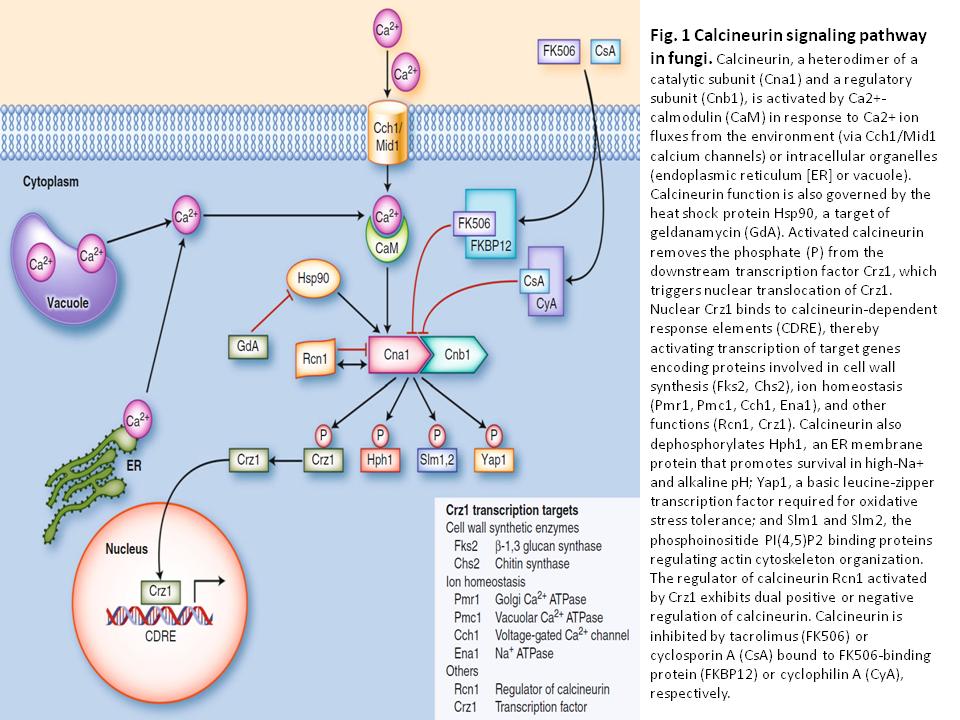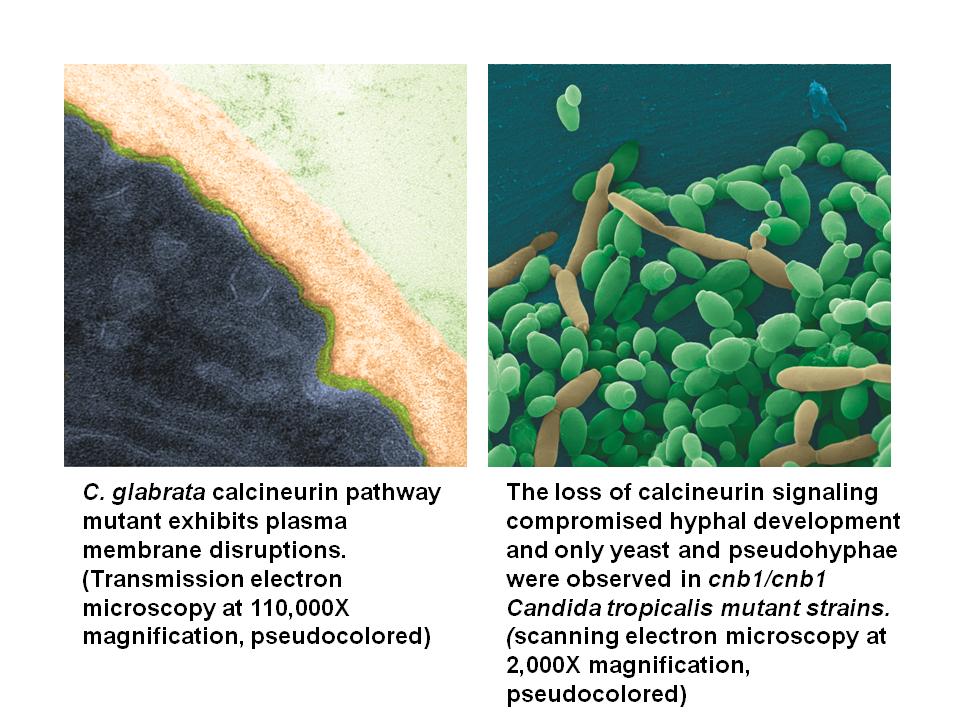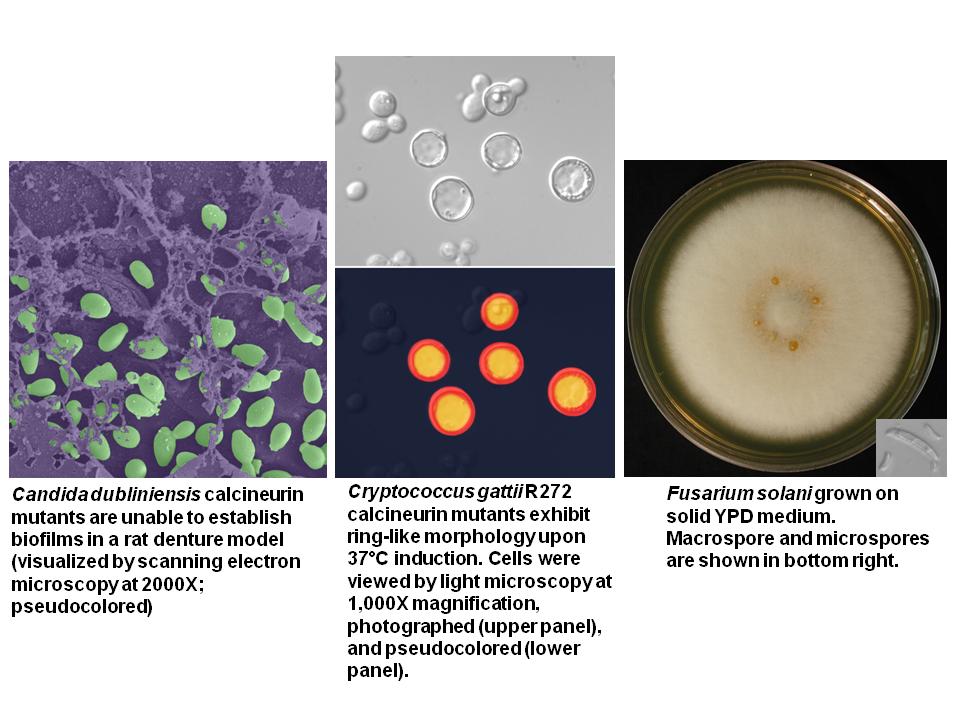|
Dr. Chen, Ying-Lien
| Title : |
Assistant Professor |
| Highest degree : |
PhD. Microbiology, University of Tennessee, USA |
| Specialties : |
Microbial Genetics, Pathogenesis, and Antifungal Drug Development |
| E-mail : |
ychen28@ntu.edu.tw |
| Office : |
Room 305/307, The First Hall |
| Telephone : |
886-2-3366-1763 ¡B 886-2-3366-4598 |
| FAX : |
886-2-2363-6490 |
Applied Microbiology Lab. |
Positions
02/2013-present |
Assistant Professor (Plant Pathology & Microbiology, NTU, Taipei, Taiwan) |
06/2009-01/2013 |
Postdoctoral Fellow (Duke University Medical Center, Durham, NC, USA) |
08/2004-05/2009 |
Teaching Assistant (University of Tennessee, Knoxville, TN, USA) |
11/2003-06/2004 |
Researcher (Asia Hepto Gene Inc., Kaohsiung, Taiwan) |
07/2000-06/2001 |
Technician (Department of Pediatrics, National Taiwan University Hospital) |
08/1998-05/2000 |
Army Sergeant (Taiwan) |
| |
|
Honors and Awards
- 2010 Meritorious Research Travel Award (Duke University)
- 2008 Science Alliance Award to outstanding graduate student (University of Tennessee)
- 2008 Woods Hole scholarship for ‘Molecular Mycology’ course. (Excellence award for in vivo research)
- 2008 Eukaryotic Cell outstanding young investigator. 9th Candida and Candidiasis Conference, American Society for Microbiology.
- 2008 David White Memorial Travel Award (University of Tennessee)
- 2008 Graduate Student Travel Grant from American Society for Microbiology (9th Candida and Candidiasis Conference, Jersey City, NJ)
- 2008 Graduate Student Senate Travel Fund Award (9th Candida and Candidiasis Conference)
- 2006 Graduate Student Senate Travel Fund Award (Yeast Genetics and Molecular Biology conference, Princeton University, NJ)
- Principal investigator (2011-2012) “Role of calcineurin in virulence of Candida species that frequently infect patients with AIDS” Agency: CFAR grant (2P30 AI64518-06, NIH-funded Center for AIDS Research at Duke University).
- Co-investigator (PI: Joseph Heitman, 2011-2012) “Validation of combination antifungal drug targets and approaches in Candida albicans isolates susceptible and resistant to caspofungin in murine models”. Agency: Merck & Co., Inc. (IISP-ID#39071).
- Co-investigator (PI: Joseph Heitman, 2011-2012) “Targeting calcineurin to develop novel antifungal drug combinations for human-pathogenic Candida species”. Agency: Astellas Pharma Inc.
- Co-investigator (PI: Joseph Heitman, 2011-2013) “Calcineurin as a drug target in pathogenic Candida species”. Co-investigator (PI: Joseph Heitman). Agency: Duke University.
- Co-investigator (PI: Mitchell Mutz, 2011-2012). “A combination therapy approach to treating drug resistant fungal infections”. Agency: NIH R43 (1R43AI096844-01; SBIR grant with Amplyx Pharma Inc.).
- Co-investigator (PI: Mitchell Mutz, 2012-2014) “A computer modeling approach to create an antifungal to improve the treatment of cryptococcal meningitis”. Agency: NIH R43 (1R43NS079204-01A1; SBIR grant with Amplyx Pharma Inc.).
- Co-investigator (PI: Mitchell Mutz, 2012-2014) “A structural approach for treating drug resistant fungal pathogens”. Agency: NIH R43 (1R43AI098300-01A1; SBIR grant with Amplyx Pharma Inc.).
Research Interests
The Chen lab focuses on investigating molecular genetics, pathogenesis, and antifungal drug development of human and plant fungal pathogens. We study these subjects in human fungal pathogens: Candida species and Cryptococcus species, which cause severe bloodstream infections (Candidemia) and cryptococcal meningitis in patients with immunocompromised conditions such as AIDS or cancer individuals. Without appropriate treatment, these infections often result in 50% death rate. In addition to basic studies, our lab also concentrates on antifungal drug development.


In studying plant fungal pathogens, we focus on the molecular biology and pathogenesis of Fusarium species including genome sequenced F. oxysporum, F. graminearum, F. verticillioides, and F. solani isolates, which are among the most important phytopathogenic and toxigenic fungi. Fusarium species have broad plant hosts and caused important diseases in Taiwan including Banana yellows(F. oxysporum f. sp. cubense) and strawberry blight (F. oxysporum f. sp. lycopersici). In addition to plant hosts, Fusarium species such as F. solani also infects humans. Therefore, we will address the evolutionary roles and relationship between plant and human Fusarium species.
 |
| |
|
Lab Members
Publications
- Yu SJ, Chang YL, Chen YL. 2015. Calcineurin signaling: lessons from Candida species. FEMS Yeast Research. In Press.
- Kim H, Jung KW, Maeng S, Chen YL, Shin J, Shim JE, Hwang S, Janbon G, Kim T, Heitman J, Bahn YS, Lee
I. 2015. Network-assisted genetic dissection of pathogenicity and drug resistance in the opportunistic human pathogenic fungus Cryptococcus neoformans. Scientific Reports.5:8767
- Chen YL*, de Bernardis F, Yu SJ, Sandini S, Kauffman S, Tams RN, Bethea E, Reynolds TB*. (2015). Candida albicans OPI1 regulates filamentous growth and virulence in vaginal infections, but not inositol biosynthesis. PLoS One. 10(1):e0116974. [*Co-corresponding author]
- Chen YL*, Yu SJ, Huang HY, Chang YL, Lehman VN, Silao FGS, Bigol UG, Bungay AAC, Averette A,
Heitman J*. (2014) Calcineurin controls hyphal growth, virulence, and drug tolerance of Candida tropicalis. Eukaryotic Cell 13(7):844-854. [*Co-corresponding author] (Featured on the cover)
- Ravu RR, Chen YL, Jacob MR, Pan X, Agarwal AK, Khan SI, Heitman J, Clark AM, and Li XC. (2013) Synthesis and antifungal activities of miltefosine analogs. Bioorganic & Medicinal Chemistry Letters 23(17):4828-4831.
- Ding C, Festa RA, Chen YL, Espart A, Palacios Ò, Espín J, Capdevila M, Atrian S, Heitman J, and Thiele DJ. (2013) Cryptococcus neoformans copper detoxification machinery is critical for fungal virulence. Cell Host & Microbe 13(3):265-276. Research highlights in Nature Reviews Microbiology, Science Daily, and Faculty of 1000.
- Chen YL, Lehman VN, Averette AF, Perfect JR, and Heitman J. (2013) Posaconazoleexhibits in vitro and in vivo synergistic antifungal activity with caspofungin or FK506 against Candida albicans. PLoS ONE 8(3):e57672.
- Chen YL, Lehman VN, Lewit Y, Averette A, and Heitman J. (2013) Calcineurin governs thermotolerance and virulence of Cryptococcus gattii. G3: Genes, Genomes, Genetics 3(3):527-539.
- Zhang J, Silao FGS, Bigol UG, Bungay AC, Nicolas MG, *Heitman J, *Chen YL. (2012) Calcineurin is required for pseudohyphal growth, virulence, and drug resistance in Candida lusitaniae. PLoS ONE 7(8): e44192. [*Co-corresponding author]
- Chen YL, Konieczka JH, Springer DJ, Bowen SE, Zhang J, Silao FGS, Bungay AC, Bigol UG, Nicolas MG, Abraham SN, Thompson DA, Regev A, Heitman J. (2012) Convergent evolution of calcineurin pathway roles in thermotolerance and virulence in Candida glabrata. G3: Genes, Genomes, Genetics 2:675-691. [Featured on the cover]
- Singh-Babak SD, Babak T, Diezmann S, Hill JA, Xie JL, Chen YL, Poutanen SM, Rennie RP, Heitman J, and Cowen LE. (2012) Global analysis of the evolution and mechanism of echinocandin resistance in Candida glabrata. PLoS Pathogens8(5):e1002718.
- Zhang J, *Heitman J, *Chen YL. (2012) Comparative analysis of calcineurin signaling between Candida dubliniensis and Candida albicans. Communicative & Integrative Biology 5(2):122-126. [Featured on the cover] [*Co-corresponding author]
- Cheon S, Jung KW, Chen YL, Heitman J, *Bahn YS, *Kang H. (2011) Unique evolution of the UPR pathway with a novel bZIP transcription factor, Hxl1, for controlling pathogenicity of Cryptococcus neoformans. PLoS Pathogens 7(8):e1002177.
- Chen YL, Brand A, Morrison E, Silao F, Bigol U, Malbas F, Nett J, Andes D, Solis N, Filler S, Averette A, *Heitman J. (2011) Calcineurin controls drug tolerance, hyphal growth and virulence in Candida dubliniensis. Eukaryotic Cell10:803-819.
- Chen YL, Kozubowski L, Cardenas ME, *Heitman J. (2010) On the roles of calcineurin in fungal growth and pathogenesis. Current Fungal Infection Reports 4:244-255. Top 2 most downloaded/popular CFIR paper.
- Chen YL, Montedonico AE, Kauffman S, Dunlap JR, Menn FM, *Reynolds TB. (2010) Phosphatidylserine synthase and phosphatidylethanolamine decarboxylase are essential for cell wall integrity and virulence in Candida albicans. Molecular Microbiology 75:1112-32.
- Chen YL, Kauffman S,*Reynolds TB. (2008) Candida albicans uses multiple mechanisms to acquire the essential metabolite inositol during infection. Infection and Immunity 76:2793-2801.
- Huang HP, Tsuei DJ, Wang KJ, Chen YL, Ni YH, Jeng YM, Chen HL, Hsu HY, Chang MH. (2005) Differential integration rates of hepatitis B virus DNA in the liver of children with chronic hepatitis B virus infection and hepatocellular carcinoma. J. Gastroenterology & Hepatology 20:1206-14.
- Huang WZ, Chung FC, Chen YL, Huang CH, and Chang YC. (2005) Development and comparison of three detection methods for calla lily-infecting Dasheen mosaic virus. Plant Pathology Bulletin 14 (4): 239-250.
- Chang YC, Chen YL, Chung FC. (2001) Mosaic disease of calla lily caused by a new potyvirus in Taiwan. Plant Disease 85:1289.
- Chao YC, and Chen YL. (1997) Influence of fluorescent pseudomonads isolated from eggplant roots on the growth and the disease development of bacterial wilt of eggplant. Bulletin of National Pingtung Polytechnic Institute 6(2):101-112.
Thesis or book chapter
- Chen YL. (2009) The roles of phospholipid biosynthesis in Candida albicans virulence. PhD dissertation. University of Tennessee, Knoxville, TN, USA.
- Chang YC, Chen YL, Chung FC. (2001) Development and application of molecular detection methods on calla lily potyvirus. Application of Biotechniques on Agriculture. pp.139-155
- Chen YL. (1998) Molecular cloning, characterization and detection of dasheen mosaic virus and a new potyvirus infecting aroids. M. S. thesis. National Taiwan University, Taipei, Taiwan.
Oral/Poster presentation in conference or invited talks
- Chen YL. Fungal pathogens: from basic biology to drug discovery. Institute of Biomedical Sciences, Academia Sinica. November 7, 2012 (Invited talk by Professor Jung-Hsiang Tai).
- Chen YL. Fungal pathogens: from basic biology to drug discovery. National institute of infectious diseases and Vaccinology, National Health Research Institutes. November 8, 2012 (Invited talk by Professor Hsiu-Jung Lo) .
- Chen YL, Konieczka JH, Springer DJ, Bowen SE, Zhang J, Silao FGS, Bungay AC, Bigol UG,Nicolas MG, Abraham SN, Thompson DA, Regev A, Heitman J. Convergent evolution of calcineurin pathway roles in thermotolerance and virulence in Candida glabrata. 11th ASM conference on Candida and Candidiasis. San Francisco, CA, USA. Mar. 29 - Apr. 2, 2012 (Oral).
- Chen YL, Konieczka JH, Springer DJ, Bowen SE, Zhang J, Silao FGS, Bungay AC, Bigol UG, Nicolas MG, Abraham SN, Thompson DA, Regev A, Heitman J. Convergent evolution of calcineurin pathway roles in thermotolerance and virulence in Candida glabrata. Keystone symposia Global Health Series (Fungal pathogens: from basic biology to drug discovery), Santa Fe, New Mexico, USA. Jan. 15-20, 2012. (Poster).
- Chen YL. Convergent evolution of calcineurin pathway roles in thermotolerance and virulence in Candida glabrata. Center for AIDS Research (CFAR), Duke University.September 28, 2011 (Invited talk by Dr. Herman Staats).
- Chen YL, Konieczka JH, Springer DJ, Bowen SE, Zhang J, Silao FGS, Bungay AC, Bigol UG, Nicolas MG, Abraham SN, Thompson DA, Regev A, Heitman J. Convergent evolution of calcineurin pathway roles in thermotolerance and virulence in Candida glabrata. The retreat of MGM department, Duke University Medical Center. Sept. 24, 2011 (Poster).
- Chen YL. Distinct roles of calcineurin pathway in Candida species. Duke University Mycology Research Unit (DUMRU). April 1, 2011 (Invited talk by Dr. Joseph Heitman).
- Chen YL and Heitman J. Calcineurin is essential for virulence and thermal stress tolerance in pathogenic Candida species 10th ASM conference on Candida and Candidiasis. Miami, FL, USA. Mar. 22-26, 2010 (Poster).
- Chen YL, de Bernadis F, Kauffman, and Reynolds TB. The Rsp1 gene regulates morphogenesis, secreted aspartyl protease transcription, and virulence in Candida albicans.9th ASM conference on Candida and Candidiasis. Jersey City, NJ, USA. Mar. 24-28, 2008 (Oral).
- Chen YL, Kauffman S, and Reynolds TB. Phosphatidylserine synthase (CaCho1p) is required for virulence and cell wall integrity in Candida albicans Southeastern Regional Yeast Meeting. Gatlinburgh, TN, USA. Mar. 7-9, 2008 (Oral).
- Chen YL, Kauffman S, Becker JM, and Reynolds TB. RSP1, a gene related to the Saccharomyces cerevisiae gene OPI1, controls morphogenesis, secreted aspartyl protease transcription and virulence in Candida albicans. Southeastern Regional Yeast Meeting.University of Alabama. AL, USA. Mar. 31- Apr. 1, 2007 (Oral).
- Chen YL, Kauffman S, and Reynolds TB.The Rsp1 gene regulates morphogenesis, secreted aspartyl protease transcription, and virulence in Candida albicans. Microbial Pathogenesis & Host Responses. Cold Spring Harbor Laboratory, NY, USA. Sept. 15-19, 2007 (Poster).
- Chen YL, Kauffman S, and Reynolds TB. SAA1, a protein related to the Saccharomyces cerevisiae gene OPI1, controls morphogenesis, secreted aspartyl protease transcription and virulence in Candida albicans. Yeast Genetics and Molecular Biology. Princeton University, NJ, USA. Jul. 25-30, 2006 (Poster).
- Chen YL, Chung FC, Chang YC. (1998) Molecular cloning and characterization of dasheen mosaic potyvirus from aroid plants in Taiwan. Plant Pathology Bulletin 7(4):226-227.
|

